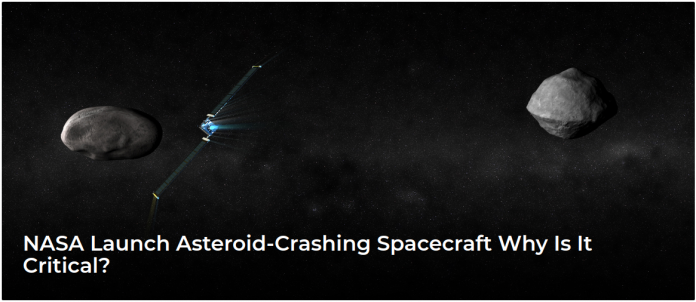From the US’s Vandenberg Space Force Base, the SpaceX Falcon 9 rocket carrying the DART (Double Asteroid Redirection Test) experiment blasted off. NASA has launched a mission to crash a spaceship into an asteroid in order to test asteroid-deflecting equipment for the first time in the world. The space probe will collide with the asteroid, which will modify its speed and trajectory.
“We’re coming for you, asteroid Dimorphos!” the space agency tweeted today, with a video of the blast-off.
NASA TV’s webcast indicated that the SpaceX Falcon 9 rocket carrying the DART (Double Asteroid Redirection Test) experiment blasted off at 10:21 p.m. Pacific Time from Vandenberg Space Force Base near California. The objective is to gently modify the trajectory of Dimorphos, a 525-foot-wide “moonlet” (160 meters, or two Statues of Liberty) that orbits a much bigger asteroid named Didymos (2,500 feet in diameter). The duo revolves around the Sun in unison.
The binary asteroid system is predicted to collide in the autumn of 2022 when it will be 6.8 million miles (11 million kilometers) from Earth, the closest it will ever go. The purpose of the test is to see if the technology is sufficient in the event that a genuine asteroid impact danger is discovered in the future.
NASA said that DART’s target asteroid is not a danger to Earth at the moment. However, the asteroid is classified as a Near-Earth Object (NEO), since it approaches the Earth within 30 million miles.
“What we’re attempting to figure out is how to deflect a danger,” NASA’s head scientist Thomas Zuburchen told news agency AFP of the $330 million, first-of-its-kind study. The spaceship, which weighs 1,344 pounds and measures 59 feet in diameter, is scheduled to hit head-on with Dimorphous.
NASA said on its website that after DART’s kinetic contact with its target asteroid, an investigative team would determine how much the impact altered the asteroid’s speed in orbit using Earth-based telescopes.
NASA’s Planetary Defense Coordination Office is particularly interested in those bigger than 460 feet in diameter since they have the ability to devastate whole cities or areas with many times the energy of conventional nuclear weapons.
There are 10,000 known near-Earth asteroids larger than 460 feet in diameter, but none has a reasonable probability of colliding with the Earth in the next 100 years. One significant caveat: experts believe there are still 15,000 such similar objects awaiting discovery.
Additionally, the DART spacecraft is equipped with advanced navigation and imaging sensors, including the Italian Space Agency’s Light Italian CubeSat for Imaging of Asteroids (LICIACube), which will monitor the collision and its aftermath.
“We expect that the CubeSat will provide us with the most stunning photograph of DART’s collision and the ejecta plume emerging from the asteroid. That will be a genuinely historic and magnificent picture “Tom Statler, DART’s programme scientist, said. According to scientists, 460-foot asteroids impact around once every 20,000 years. Asteroids six miles or more in diameter, such as the one that impacted 66 million years ago and wiped out the majority of life on Earth, including the dinosaurs, occur around every 100–200 million years.















